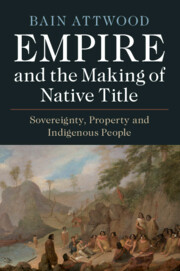Book contents
- Empire and the Making of Native Title
- Empire and the Making of Native Title
- Copyright page
- Dedication
- Contents
- Acknowledgements
- Abbreviations
- Principal Players
- Maps
- Introduction
- 1 Claiming Possession in New Holland and New Zealand, 1770s–1820s
- 2 Batman’s Treaty and the Rise and Fall of Native Title, 1835–1836
- 3 The South Australian Colonisation Commission, the Colonial Office and Aboriginal Rights in Land, 1834–1837
- 4 Protection Claims and Sovereignty in the Islands of New Zealand, 1800–1839
- 5 Making Agreements and a Struggle for Authority, 1839–1840
- 6 The Land Claims Commission and the Return of the Treaty, 1840–1843
- 7 A Colony in Crisis and a Select Committee, 1843–1844
- 8 The Retreat of the Government and the Rise of the Treaty, 1844–1845
- 9 The Making of Native Title, 1845–1850
- Conclusion
- Appendix: The English Text of the Treaty of Waitangi
- Bibliography
- Index
3 - The South Australian Colonisation Commission, the Colonial Office and Aboriginal Rights in Land, 1834–1837
Published online by Cambridge University Press: 03 July 2020
- Empire and the Making of Native Title
- Empire and the Making of Native Title
- Copyright page
- Dedication
- Contents
- Acknowledgements
- Abbreviations
- Principal Players
- Maps
- Introduction
- 1 Claiming Possession in New Holland and New Zealand, 1770s–1820s
- 2 Batman’s Treaty and the Rise and Fall of Native Title, 1835–1836
- 3 The South Australian Colonisation Commission, the Colonial Office and Aboriginal Rights in Land, 1834–1837
- 4 Protection Claims and Sovereignty in the Islands of New Zealand, 1800–1839
- 5 Making Agreements and a Struggle for Authority, 1839–1840
- 6 The Land Claims Commission and the Return of the Treaty, 1840–1843
- 7 A Colony in Crisis and a Select Committee, 1843–1844
- 8 The Retreat of the Government and the Rise of the Treaty, 1844–1845
- 9 The Making of Native Title, 1845–1850
- Conclusion
- Appendix: The English Text of the Treaty of Waitangi
- Bibliography
- Index
Summary
We can only understand the positions that British parties adopted in respect of Aboriginal interests in land of grasp that this matter arose only incidentally and that those positions were a product of political contestation between these players. Furthermore, there are no sound historical reasons for suggesting that the Colonial Office’s senior officials sought to uphold native rights of property in land in the colony of South Australia. They made vague and formulaic references to the possibility that there might be native peoples who had native title to land, but they did so in trying to rein in the colonisation proposed by the South Australia Colonisation Commission. It is naïve to suggest that their position on the native people’s interests in land was a product of a commitment to some high-minded religious, moral or legal principles. While they held that they had a duty to protect the interests of the native peoples, they were convinced that there were very real political limits to any attempt to uphold any rights that Aboriginal people might have. This conviction owed a good deal to their perceptions of the relative power of the imperial and colonial government, the settlers and the Aboriginal people.
Keywords
- Type
- Chapter
- Information
- Empire and the Making of Native TitleSovereignty, Property and Indigenous People, pp. 65 - 95Publisher: Cambridge University PressPrint publication year: 2020



